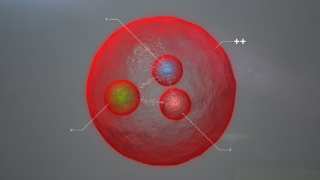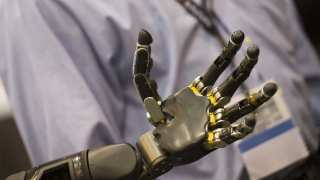Dr. Luis A. Diaz Jr. and colleagues recently reported a way to unmask a class of cancer cells responsible for about 4% of all cancers. New treatments may help as many as 60,000 patients a year in the US.

Leviathan by Thomas Hobbes; engraving by Abraham Bosse (Public Domain)
Human cells are citizens of the multicellular body. Descended from a single fertilized egg, they multiply by cell division until there are trillions of them. Many types of cells continue to divide throughout a person’s lifetime. Although reproduction is tightly regulated, cancer cells disobey these norms and proliferate inappropriately. This disrupts the domestic tranquility of the body.
To Err is Human
There is about a 60% chance that a cell will be born with a mutation; the odds are worse if one is exposed to mutagenic chemicals or radiation. There is a small chance that any one mutation might affect a gene that has a role in cell division. This is probably why cancer rates begin to increase dramatically at age 45. It seems that, sometimes, by this age enough cells have accumulated enough mutations to deregulate the control of cell growth- starting cells on the road to becoming cancerous. Of course, not everyone gets cancer, but it becomes more likely the longer one lives and one’s cells continue to reproduce.
The situation would be 100 times worse if not for mismatch repair enzymes that correct 99% of the mistakes (mismatches of DNA sequences) made by the enzymes that replicate DNA.
Some people are born with an inability to correct DNA mismatches. As a result, they have a very high rate of cancer incidence. Others develop mutations that disrupt mismatch repair during their lifetime. That is, they acquire a mutation that leads to many more mutations.
War is Peace
However, it is not all bad news. The body politic has a police force that scours the tissues looking for cells that have gone bad. We know this is true because people with weak immune systems, AIDS patients or those taking immunosuppressive drugs, have a higher incidence of cancer. The specific cell type that is important in cancer surveillance is the T-cells. They get their name from the thymus, where the vast majority mature. B-cells are more concerned with producing molecules, called antibodies, against foreign invaders. (B-cells get their name from an organ in chickens that humans don’t have, the bursa of fabricus).
Moderation in All things
T-cells are so aggressive that they have to be trained not to attack normal cells. It is remarkable that the immune system can build molecules that will recognize all the different substances that they should attack, yet avoid attacking normal cells of the body. (“normal-self cells”) Apparently, the immune system generates millions of molecular receptors by random processes: some will be useful against dangerous cells (“altered-self”), some won’t recognize anything, and some will recognize molecules from normal-self cells.
As a developing fetus, the body sorts through the T-cells and B-cells and discards those that haven’t been able to produce recognition molecules, or that produce recognition molecules that recognize normal self.
T-cells carry a protein on their surface, PD-1, that when activated, tells T-cells to stand down. “PD” stands for “programmed death.” The rogue T-cell is sometimes compelled to commit suicide rather than attack the law-abiding citizenry of the body.
The cells that can order the cell-suicide carry another protein, PD-L1, which binds PD-1. Sometimes, cells with PD-L1 go out into the body to calm the T-cells down when they are over-responding to something.
Unfortunately, cells with mismatch repair defects often learn to carry PD-L1! When the T-cells show up to take the cancer cells down, these traitors use PD-1 to sweet-talk the T-cells into leaving them alone.
Excess in Defense
Remember the B-cells? They make antibodies that bind foreign molecules (“non-self”). Scientists can trick B-cells into making antibodies that will bind their favorite molecule. Several drug companies have developed antibodies that bind PD-1. These are an example of a class of drug called immunotherapies.
Merck’s version is called Pembrolizumab or Keytruda. (When you see a drug name that ends in “-mab,” that means that it is a “monoclonal antibody,” an artificial mass-produced antibody.) When it binds to PD-1, it apparently prevents the T-cell from being shut down-effectively “unmasking” the hiding tumor cell. Once the T-cells are given free rein, they descend on the cancer cells with mismatch repair defects like a SWAT team. All the mutations produced by the mismatch repair defect make these cancer cells a prime target. They are very, very, altered self.
In the study by the Diaz group, 86 patients with tumors exhibiting mismatch repair defects that did not respond to standard treatments were given Keytruda. 66 of the 86 patients showed significant benefit from the treatment. At the least, their tumors didn’t grow. 18 of the 66 had their tumors disappear.
The results were so promising that the drug is approved for tumors anywhere in the body that exhibit the mismatch repair defect. This is striking because anti-tumor drugs are usually only approved for specific kinds of tumors that develop in specific tissues.

Adrienne Skinner of Larchmont, N.Y., had an extraordinarily rare and deadly cancer with no standard treatment. She started taking Keytruda in 2014 and her tumor is gone. (Whitten Sabbatini for The New York Times)
Interestingly, an unfortunate side effect of this drug is that it may cause severe autoimmunity, when T-cells attack normal cells. So, the T-cells are free to attack the tumor and free to attack normal cells. The side effects do seem manageable though, when compared to the benefits.
Know Thy Self, Know Thy Enemy
The idea for the Diaz group’s breakthrough came from the observation that only rare patients benefited from PD-1 inhibition. What was special about these individuals? It turned out that these patients’ tumors often exhibited mismatch repair defects. So, in this new study PD-1 inhibition was tested only on people with mismatch repair defects- with great success. But not complete success, as scientists in the field of immunotherapy will now investigate why some of patients with mismatch repair defects do not respond to PD-1 inhibition. This will hopefully enable new insights that will help physicians help the immune system to win the civil war on cancer.
Top image: Keytruda A New Approved Cancer Drug (YouTube)
References
Kolata, G., 2017. Cancer Drug Proves to Be Effective Against Multiple Tumors. The New York Times, 8 June.
LE, D. T., et al. 2017. Mismatch-repair deficiency predicts response of solid tumors to PD-1 blockade.
[Online]
Available at: http://science.sciencemag.org/content/early/2017/06/07/science.aan6733.long
[Accessed 21 June 2017].
Ono Pharmaceutical, n.d. Oncology. [Online]
Available at: https://www.ono-oncology.jp/contents/patient/opdivo_about/03.html
[Accessed 21 June 2017].







No comment